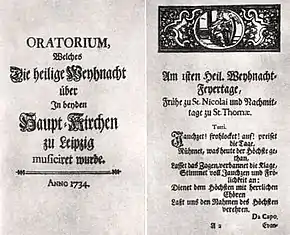Ehre sei dir, Gott, gesungen (Let honour be sung to You, O God),[1] BWV 248V (also written as BWV 248 V), is a church cantata for the second Sunday after Christmas, which Johann Sebastian Bach composed as the fifth part of his Christmas Oratorio, written for the Christmas season of 1734–35 in Leipzig.[2] The Christmas cantata was first performed on 2 January 1735.[2][3] Bach was then Thomaskantor, responsible for music at four churches in Leipzig, a position he had assumed in 1723.
History
Bach had been presenting church cantatas for the Christmas season in the Thomaskirche (St. Thomas) and Nikolaikirche (St. Nicholas) since his appointment as director musices in Leipzig in 1723, including these cantatas for the Sunday after New Year's Day:[4][5][6]
- As part of his first cantata cycle: Schau, lieber Gott, wie meine Feind, BWV 153, first performed on 2 January 1724.[7]
- As part of his third cantata cycle: Ach Gott, wie manches Herzeleid, BWV 58 (early version), first performed on 5 January 1727, and in its later version, first performed on 4 January 1733 or 3 January 1734, added to the chorale cantata cycle.[8]
Christmas season 1734–35

Bach composed his Christmas Oratorio for the Christmas season from Christmas Day on 25 December 1734 to Epiphany on 6 January 1735.[10] Ehre sei dir, Gott, gesungen, BWV 248 V, for the Sunday after New Year's Day, is the fifth of six cantatas (or parts) constituting this oratorio.
Text
The readings for the Sunday were as the epistle 1 Peter 4:12–19, the suffering of Christians, and as the Gospel Matthew 2:13–23, the Flight into Egypt. The text of Part V, deviating from these readings, deals with the voyage of the Magi, following the Gospel of Matthew, 1–6,[10] with interspersed reflecting recitatives, arias and chorales.[11]
The identity of the librettist of the Christmas Oratorio cantatas is unknown,[3] with Picander, who had collaborated with Bach earlier, a likely candidate.[12] The oratorio's libretto was published in 1734.[9] The quotations from the Bible are rendered in Martin Luther's translation.
Music and content
BWV 248 V is scored for 2 oboes d'amore, 2 violin parts, 1 viola part and continuo.[2]
| No. | Key | Time | Incipit | Scoring | Model | |
|---|---|---|---|---|---|---|
| 43 | Chorus | A maj/F♯ min | 3 4 | Ehre sei dir, Gott, gesungen | Oboe d'amore I, II, strings, continuo | |
| 44 | Recitative (Evangelist, tenor) | Da Jesus geboren war zu Bethlehem | Continuo | Matthew 2:1 | ||
| 45 | Chorus Recitative (alto) Chorus | D major | Wo ist der neugeborne König der Juden Sucht ihn in meiner Brust Wir haben seinen Stern gesehen | Oboe d'amore I, II, strings, continuo | Matthew 2:2; BWV 247/43: "Pfui dich, wie fein zerbrichst du den Tempel" (conjectured).[13] | |
| 46 | Chorale | A major | Dein Glanz all' Finsternis verzehrt | Oboe d'amore I, II, strings, continuo | Nun liebe Seel, nun ist es Zeit (Weissel 1642), v. 5; Zahn 2461c (1581)[14] | |
| 47 | Aria (bass) | F♯ minor | 2 4 | Erleucht' auch meine finstre Sinnen | Oboe d'amore I solo, organ senza continuo | BWV 215/7: "Durch die von Eifer entflammeten Waffen" |
| 48 | Recitative (Evangelist, tenor) | Da das der König Herodes hörte | Continuo | Matthew 2:3 | ||
| 49 | Recitative (alto) | Warum wollt ihr erschrecken | Strings, continuo | |||
| 50 | Recitative (Evangelist, tenor) | Und ließ versammeln alle Hohenpriester | Continuo | Matthew 2:4-6 | ||
| 51 | Trio (sopr., alto, ten.) | B minor | 2 4 | Ach! wann wird die Zeit erscheinen? | Violin I solo, continuo | unknown |
| 52 | Recitative (alto) | Mein Liebster herrschet schon | Continuo | |||
| 53 | Chorale | A major | Zwar ist solche Herzensstube | Oboe d'amore I, II, strings, continuo | Ihr Gestirn, ihr hohlen Lüfte (Franck 1655), v. 9; Zahn 3614b (1687)[15] | |
References
- ↑ Dürr & Jones 2006, p. 169.
- 1 2 3 Bach Digital Work 11389
- 1 2 Bach Digital 248 V 2021.
- ↑ Wolff 2002, pp. 237–257.
- ↑ Dürr & Jones 2006, pp. 22–35.
- ↑ Buelow 2016, p. 272.
- ↑ Bach Digital Work 00187
- ↑ Bach Digital Works 00074 and 00073
- 1 2 BWV 248, Bach Digital
- 1 2 Hofmann 2005, p. V.
- ↑ Dürr & Jones 2006.
- ↑ Dürr & Jones 2006, p. 104.
- ↑ Werner Breig, sleeve notes to John Eliot Gardiner's recording of the Christmas Oratorio (Deutsche Grammophon Archiv, 4232322, 1987)
- ↑ "Work 11265". Bach Digital. Leipzig: Bach Archive; et al. 2018-07-15.
- ↑ "Work 11267". Bach Digital. Leipzig: Bach Archive; et al. 2018-07-15.
Sources
- "Ehre sei dir, Gott, gesungen / (Christmas oratorio, part 5) BWV 248.2 V; BWV 248 V; BC D 7 V". Bach Digital. 2021. Retrieved 4 January 2022.
- Buelow, George J. (2016). "The Late Baroque Era". The Late Baroque Era: Vol 4. From The 1680s To 1740. Springer. ISBN 978-1-34-911303-3.
- Hofmann, Klaus, ed. (2005). Johann Sebastian Bach: Weihnachtsoratorium / Christmas Oratorio / Oratorium Tempore Nativitatis Christi / BWV 248 (PDF) (Urtext, Vocal score). Stuttgarter Bach-Ausgaben (in German, English, and French). Translated by Coombs, John. Continuo realisation by Horn, Paul, English version by Drinker, Henry S. Carus. CV 31.248/53.
- Dürr, Alfred; Jones, Richard D. P. (2006). The Cantatas of J. S. Bach: With Their Librettos in German-English Parallel Text. Oxford University Press. pp. 102–105, 820. ISBN 978-0-19-929776-4.
- Wolff, Christoph (2002). Johann Sebastian Bach: The Learned Musician. W. W. Norton & Company. ISBN 978-0-393-32256-9.